UPSC Daily Current Affairs: 14 August 2024 | Current Affairs & Hindu Analysis: Daily, Weekly & Monthly PDF Download
GS1/Social Issues
ILO to help Eliminate Child Labour, Forced Work in Cotton Fields
Source: The Hindu

Why in news?
International Labour Organisation (ILO) is collaborating to eradicate child labour and forced work in India's cotton fields.
What is Child Labour?
- The term child labour refers to work that robs children of their childhood, potential, and dignity, hindering their physical and mental development.
- Whether an activity qualifies as child labour depends on factors like the child’s age, type of work, hours worked, and working conditions, varying across nations.
International Organisations w.r.t. Child Labour:
- United Nations Children’s Fund (UNICEF)
- International Labour Organisation (ILO)
United Nations Children’s Fund (UNICEF)
- UNICEF, a UN agency, aims to provide aid to children globally, guided by the Convention on the Rights of the Child, 1989.
- It operates on voluntary contributions, focusing on community-level services for children’s health and well-being.
International Labour Organisation (ILO)
- Established in 1919, the ILO is the oldest UN specialized agency, dedicated to promoting social and economic justice through global labour standards.
- It features a tripartite structure involving governments, employers, and workers to devise labour policies for decent work.
Child Labour in India:
- Approximately 12.9 million Indian children, aged 7 to 17, are engaged in work.
- Rural areas harbor 80% of child labourers in India, with Uttar Pradesh hosting the highest number.
- Children often undertake domestic tasks besides industrial and agricultural work.
Child Labour (Prohibition and Regulation) Amendment Act, 2016
- The Act prohibits employment of children under 14 years and restricts adolescents (14-18 years) from hazardous work.
- Children are allowed to work only in family settings or as artists outside school hours.
- The Act mandates the establishment of a fund for rehabilitating child and adolescent labourers.
- The 2017 Amendment Rules detail State and District roles for effective enforcement.
ILO to help Eliminate Child Labour, Forced Work in Cotton Fields
- The Confederation of Indian Textile Industry and ILO initiated a project to end child and forced labour in Indian cotton fields.
- The initiative, "Promoting Fundamental Principles and Rights at Work," targets 65 lakh cotton farmers across 11 states.
- It aims to ensure freedom of association, eliminate discrimination, and provide a safe working environment.
- The collaboration offers support for government schemes, financial inclusion, and education programs in cotton-growing areas.
GS2/Polity
Joint Parliamentary Committees (JPC) on Financial Allegations
Source: The Hindu
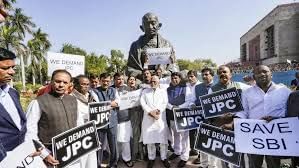
Why in News?
The Opposition has demanded a Joint Parliamentary Committee (JPC) to investigate the Hindenburg Research allegations against SEBI’s chairperson Madhabi Puri Buch.
What is a Joint Parliamentary Committees (JPC)
- JPCs are set up by a motion passed in one house of Parliament and agreed to by the other.
- Its members include MPs from both the Lok Sabha and Rajya Sabha.
- A JPC is an ad-hoc body that acts as a mini-Parliament to carry out detailed scrutiny of a specific matter within a specific time frame.
How many JPCs have there been so far?
- 4 major JPCs have been formed to investigate significant issues that have caused controversy.
- These include Joint Committee on Bofors Contracts, Joint Committee on irregularities in securities and banking transactions, Joint Committee on stock-market scam, and Joint Committee on pesticide residues in and safety standards for soft drinks.
The details regarding membership and subjects
- The composition of JPCs is decided by Parliament, with different numbers of members based on the issue being investigated.
- For example, the JPC on the stock market scam had 30 members, while the JPC on pesticides had 15 members.
- The terms of reference for JPCs outline their investigative scope and objectives.
Effectiveness of JPCs
- JPC recommendations hold persuasive value but cannot compel the government to take specific actions.
- The government may choose to initiate further investigations based on JPC reports.
- JPCs are required to submit 'Action Taken Reports' to Parliament, which can lead to discussions and questioning in the government.
JPCs to Investigate Alleged Financial Crimes
- 2G Spectrum (2013): Cleared then PM Manmohan Singh of wrongdoing related to granting licenses for Unified Access Services.
- Share Market Scam (2001): Recommended regulatory changes in the stock market, but not all recommendations were implemented.
- Securities and Banking Transactions (1992): Investigated allegations against Harshad Mehta for diverting funds.
GS3/Environment
Movement of Ballast Water in India
Source: The Hindu
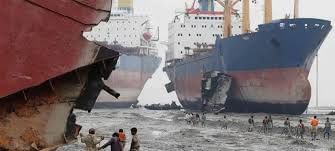
Why in news?
The Tamil Nadu Water Resources Department (WRD) has requested ₹160 crore from Kamarajar Port in Ennore, Tamil Nadu, to tackle the removal of invasive charru mussels (Mytella strigata) along the coast. These mussels are causing harm to marine ecosystems and impeding fisher boat movements, thereby affecting livelihoods. The WRD has accused Kamarajar Port of aiding the spread of the invasive species by neglecting to regulate ballast water from ships.
About Invasive Species
- Invasive species are non-native organisms introduced, whether accidentally or intentionally, into a new environment where they are not naturally found.
- These species tend to spread rapidly and can cause significant harm to local ecosystems, economies, and human health.
Introduction to Ballast Water
- Ships use ballast water to stabilize vessels.
- This water often carries various marine organisms.
- When discharged in a new location, it can introduce invasive species to the area.
Case Study: Charru Mussels (Mytella strigata)
- These mussels, native to South America, have spread to regions like the coast near Kamarajar Port.
- The unregulated discharge of ballast water from ships is a primary cause of their spread.
Threats Posed by Charru Mussels
- Rapid reproduction leading to dense colonies
- Competition with native species for space and resources
- Attachment to various surfaces, disrupting habitats
Background
- Traditionally, there were no restrictions on the intake and discharge of ballast water.
- However, due to the potential harm to ecosystems, regulations have been introduced globally.
Global Regulations
- The Ballast Water Management (BWM) Convention, enforced by the International Maritime Organization (IMO) since 2017, aims to prevent the spread of harmful aquatic organisms through ships' ballast water.
- Countries like Australia and New Zealand strictly enforce these regulations to protect marine ecosystems.
Situation in India
- India has not signed the BWM Convention, leading to unchecked ballast water discharge at its ports.
- Joining the convention is crucial to address this gap in regulation.
Way Forward for India
- Experts suggest that ports cannot be held liable unless specific laws are in place.
- India must join the BWM Convention to hold vessel owners accountable for invasive species spread through ballast water.
GS1/Geography
TUNGABHADRA
Source: Indian Express
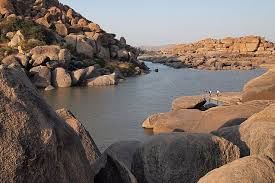
Why in news?
A flood alert has been sounded downstream of the Tungabhadra dam in Karnataka’s Koppal district after one of the crest gates of the massive stone masonry dam across the Tungabhadra river was washed away.
Background:-
About Tungabhadra river and dam
- The Tungabhadra River originates in Karnataka and flows primarily through the state before entering Andhra Pradesh, where it eventually merges with the Krishna River.
- The river Tungabhadra derives its name from two streams viz., the Tunga, and the Bhadra which rise in the Western Ghats.
- The river after the confluence of the two streams near Shimoga, runs for about 531 km till it joins the river Krishna at Sangamaleshwaram in Andhra Pradesh.
- It runs for 382 km in Karnataka, forms the boundary between Karnataka and Andhra Pradesh for 58 km and further runs for the next 91 km in Andhra Pradesh.
- The confluence of Tungabhadra and Krishna River is a holy pilgrimage site – The Sangameswaram Temple.
- Hampi one of the important heritage locations being listed by UNESCO is on the banks of the Tunga Bhadra River.
- Nava Brindavan, an island where the final resting location of nine holy Madhva saints is in the midst of the Tunga Bhadra River.
- It is influenced chiefly by the South-West monsoon. It is a perennial river but the summer flows dwindle to as low as 2.83 to 1.42 cumec.
Tungabhadra Dam
- The Tungabhadra reservoir sprawls over an area of 378 sq km primarily in Karnataka's Vijayanagar district.
- It is one of the major reservoirs in South India that supplies water for irrigation and industrial use, as well as drinking water to Karnataka and Andhra Pradesh.
- The dam was first conceived of in 1860 to mitigate the impact of recurrent famine in Rayalaseema.
- Construction was begun by the erstwhile governments of Hyderabad and Madras in 1945, and the project was completed in 1953.
- The Tungabhadra Board was established by a presidential order in 1953.
- The Board currently has a chairman appointed by the Union government, and four members, representing the Union government and the states of Karnataka, Andhra Pradesh, and Telangana.
- The Tungabhadra reservoir and the Mullaperiyar dam in Kerala hold the unique distinction of being the only two reservoirs in the country that were built using a combination of mud and limestone.
GS3/Science and Technology
BIOFORTIFIED CROPS
Source: The Print

Why in news?
Recently, the Prime Minister of India unveiled 109 high yielding, climate resilient, and biofortified crop varieties at the India Agricultural Research Institute in New Delhi. This release marks a significant stride in fortifying and safeguarding Indian agriculture for the future.
About Biofortification
- Biofortification Definition: Biofortification involves enhancing the nutritional value of food crops.
- Methods:
- Conventional Breeding: This method focuses on breeding plants with naturally higher nutrient levels, gradually boosting the crops' nutritional content.
- Genetic Engineering: This approach involves directly altering a plant's genes to elevate specific nutrient levels.
- Objective: The primary aim is to develop and distribute crops naturally abundant in vital micronutrients, ensuring elevated levels of essential vitamins, minerals, and nutrients.
Benefits of Biofortification
- Enhanced Nutrition: Combats micronutrient deficiencies, particularly in regions with low to moderate incomes.
- Enhanced Accessibility: Provides crucial nutrients to rural communities lacking access to commercially fortified foods.
Examples of Biofortified Crops
- Golden Rice: Engineered with beta-carotene to address vitamin A deficiency.
- Iron and Zinc-Enriched Wheat: Developed using radiation breeding techniques to enhance iron and zinc content.
GS3/Science and Technology
DISTRIBUTED DENIAL-OF-SERVICE (DDOS) ATTACK
Source: Indian Express
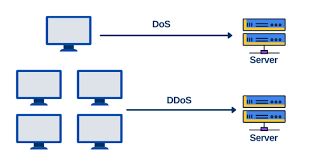
Why in news?
A conversation between Republican presidential candidate Donald Trump and billionaire Elon Musk on Musk’s social media platform X was disrupted by technical glitches, which Musk attributed to a DDoS attack. The conversation was highly anticipated, marking Trump’s notable return to X after his 2021 ban from Twitter following the Capitol riots. Musk has strongly endorsed Trump as presidential candidate, so bringing the former president onto his platform for a conversation was a move that captured public attention.
Key takeaways
- A Distributed Denial-of-Service (DDoS) attack aims to disrupt the normal traffic of a targeted server, service, or network by overwhelming it with a flood of internet traffic.
How DDoS Attacks Work
- Botnets: DDoS attacks are typically carried out using networks of internet-connected devices (botnets) that have been infected with malware. These devices, often referred to as bots or zombies, are controlled remotely by the attacker.
- Traffic Flooding: The attacker directs the botnet to send an overwhelming amount of traffic to the target’s IP address. This can exhaust the target’s bandwidth, RAM, or other resources, causing the system to slow down or crash.
Types of DDoS Attacks
- Volume-based attacks: These aim to saturate the bandwidth of the target site.
- Protocol attacks: These focus on exploiting weaknesses in network protocols.
- Application layer attacks: These target specific applications or services.
Identifying a DDoS Attack
- A sudden slowdown or unavailability of a site or service is a common sign. Other indicators include unusual traffic patterns, such as spikes at odd hours or a flood of traffic from a single IP address.
Motivations Behind DDoS Attacks
- Financial Gain: Attackers may demand ransom to stop the attack.
- Competitor Sabotage: Businesses may use DDoS attacks to disrupt competitors.
- Hacktivism: Individuals or groups may launch attacks to make a political statement.
GS3/Economy
Civil Registration System (CRS) Portal Facing Glitches
Source: The Hindu
 Why in news?
Why in news?
The Union government's centralised Civil Registration System (CRS) portal, used for registering births and deaths, has been facing technical issues for the past four months, causing delays in the issuance of certificates.
- Under the Registration of Births and Deaths (Amendment) Act of 2023, all births and deaths in India from October 1, 2023, must be digitally registered through this portal.
- So far 23 states & 6 UTs have migrated to this new portal.
- The digital birth certificates will serve as a single document for various services, including education, government jobs, and marriage registration.
- Additionally, the centralised database will update the National Population Register (NPR), which has 119 crore residents and serves as a precursor to the National Register of Citizens (NRC) under the Citizenship Act.
Civil Registration System (CRS) in India
- With the enactment of the Registration of Births and Death Act (RBD Act) in 1969, the registration of births, deaths and still births have become mandatory in India.
- The Registrar General, India (RGI) at the Central Government level coordinates and unifies the activities of registration throughout the country.
- However, implementation of the statute is vested with the State Governments.
- The registration of births and deaths in the country is done by the functionaries appointed by the State Governments.
- The Chief Registrar of Births and Deaths is mandated to publish a statistical report on the registered births and deaths during the year.
Uniform Software Application for Registration of Births and Deaths
- A software application for online and offline registration of birth and death has been developed.
- The application that is presently available in English is being customized in 13 Indian languages.
Database of Institutions
- A nationwide database of medical Institutions has been prepared.
- The plan is to electronically monitor the registration of events occurring in these institutions through an ICT enabled platform.
Application to Monitor Institutional Events
- An SMS based application called "Event Monitoring System for Registration" has been developed and is currently under pilot testing.
Data digitization
- Project to keep old records easily located to retrieve digital form has been started.
- This will help in storage of registers in electronic format and allow easy access to the records.
Capacity Building of Registrars:
- Training the registration functionaries in 13 languages by providing financial assistance to the State Governments.
GS2/Polity
HOW WILL SHEIKH HASINA'S EXIT IMPACT INDIA
Source: The Hindu
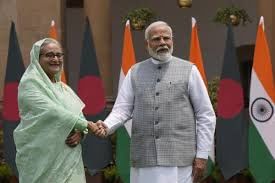
Why in news?
After protests in Bangladesh forced former Prime Minister Sheikh Hasina to flee to India, her future remains unclear. While the Modi government has provided her shelter, it is also engaging with the new regime, assessing the impact of Bangladesh's political changes on India's relations with the country.
Impact of Sheikh Hasina's Ouster on India
- Setback for India: Sheikh Hasina's removal is a significant setback for India, jeopardizing the progress made in economic ties, border security, defense, trade, and connectivity.
Transformation Under Hasina
- Strong Ties with India:
- Since her 2009 return to office, Hasina prioritized strong relations with India, cracking down on terror camps, campaign against religious radicalisation, addressing border tensions, and extradited over 20 "most wanted" men accused of terrorism and crime to India.
- In sharp contrast to her predecessor Khaleda Zia's government, Ms. Hasina also worked on ending border tensions caused by illegal immigration into India. Several border patrolling agreements and the signing of the historic 2015 land boundary agreement followed.
- Economic and Trade Cooperation:
- India provided trade concessions and low-interest Lines of Credit, helping Bangladesh transform into a developing country with improved human development indices. Bangladesh has become a lynchpin to India's regional connectivity plans to Southeast Asia and the Indo-Pacific, and an important buyer of Indian energy off the subcontinental grid.
- Support on Key Issues:
- Hasina supported India on various issues, including boycotting SAARC due to terrorism from Pakistan and backing the Citizenship Amendment Act despite protests in Bangladesh.
Future Relations with the New Government
- Engagement with New Regime:
- India is engaging with the interim government led by Muhammad Yunus, though complications arise due to Hasina's presence in India and potential future demands for her extradition.
- Uncertainty with BNP:
- If the BNP, led by Khaleda Zia, wins future elections, India's experience could be challenging, given past tensions and increased influence from China and Pakistan.
- Minority Concerns:
- Modi's appeal for the safety of minorities in Bangladesh and the establishment of a committee to maintain communication with Bangladesh to ensure the safety of Indian citizens and people belonging to minority communities may complicate ties with Dhaka further.
Changes in Bangladesh's Foreign Relations
- Improved U.S. Ties:
- Relations with the U.S. may improve, as the Hasina government was often at odds with Washington.
- Shifts with Pakistan and China:
- Relations with Pakistan may thaw, and China is expected to maintain strong ties with the new government, continuing its influence through the Belt and Road Initiative.
GS3/Economy
NATIONAL INSTITUTIONAL RANKING FRAMEWORK (NIRF)
Source: Economic Times
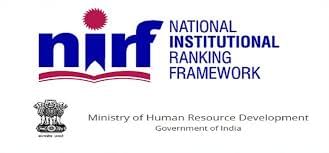
Why in news?
The Ministry of Education introduced the National Institutional Ranking Framework (NIRF) for 2024. IIT Madras has secured the top position for the sixth consecutive year, with IISc, Bengaluru, being recognized as the best university. Notably, IIT Madras maintains its status as the leading engineering college in India for the ninth year. Top 5 institutions in the management category include IIM Ahmedabad, Bangalore, and Calcutta.
About National Institutional Ranking Framework (NIRF)
- The NIRF, established by the Ministry of Education, aims to rank higher education institutions in India reliably and comprehensively.
- Introduced in September 2015, the framework assesses institutions based on parameters like teaching, learning resources, research, graduation outcomes, outreach, inclusivity, and perception.
- Participation in NIRF 2024 involved 10,885 higher education institutions.
Key objectives
- Transparency and Accountability: NIRF strives to offer a transparent and accountable ranking system that stakeholders can rely on.
- Informed Decision-Making: The framework aids students, parents, and educators in making well-informed decisions regarding higher education choices.
- Encouraging Excellence: Institutions are motivated to excel in education and research realms.
- Benchmarking: NIRF sets benchmarks for institutions to compare their performance with peers.
- Policy Formulation: The framework helps policymakers identify strengths and areas for improvement in the higher education sector.
- Resource Allocation: NIRF assists in resource allocation and funding based on performance metrics.
GS2/Governance
GOVERNANCE IN DELHI
Source: The Hindu

Why in news?
The Supreme Court's recent ruling allows the Lieutenant Governor of Delhi to independently nominate 10 aldermen to the Municipal Corporation of Delhi without consulting the council of ministers, leading to increased tensions among the Union government, the Delhi government, and the local administration.
Evolution of the Delhi Government
- 1950: Delhi started as a Part C State.
- 1956: During States Reorganisation, Delhi became a Union Territory under an administrator's governance.
- The Municipal Corporation of Delhi (MCD) was formed in 1958, establishing a limited local government from 1966.
- 1991: The 69th Constitutional Amendment, following the Balakrishnan Committee's recommendations, granted Delhi a Legislative Assembly and council of ministers. However, public order, police, and land remained under the Union government's control. The Government of NCT of Delhi Act, 1991 outlined provisions for Delhi's legislature, executive, and administration.
Present Issues
- Political Conflict (2015-Present): Ongoing disputes between the Union government (BJP) and the Delhi government (AAP) over various matters.
- Modifications to the Government of NCT of Delhi Act due to Supreme Court rulings have restricted the powers of the elected Delhi government.
- MCD and Local Governance: The MCD, along with its elected representatives, contribute to the challenges, evident in recent incidents like fatalities from electrocution and flooding in Delhi.
- Elected officials' blame-shifting undermines public accountability.
Proposed Way Forward
- In its 2023 judgment, the Supreme Court highlighted the importance of a triple chain of accountability in a democracy.
- The ongoing power struggles disrupt this accountability chain.
- Potential Structural Changes: The NCT of Delhi spans 1,450 sq km, with New Delhi covering about 50 sq km.
- One proposed approach, similar to Washington DC, suggests placing 50-100 sq km of New Delhi under complete Central government jurisdiction while the rest falls under the Delhi Assembly's governance.
- Implementing this requires a constitutional amendment, with adherence to the essence of the Supreme Court's 2023 ruling in the interim.
|
38 videos|5264 docs|1112 tests
|





















